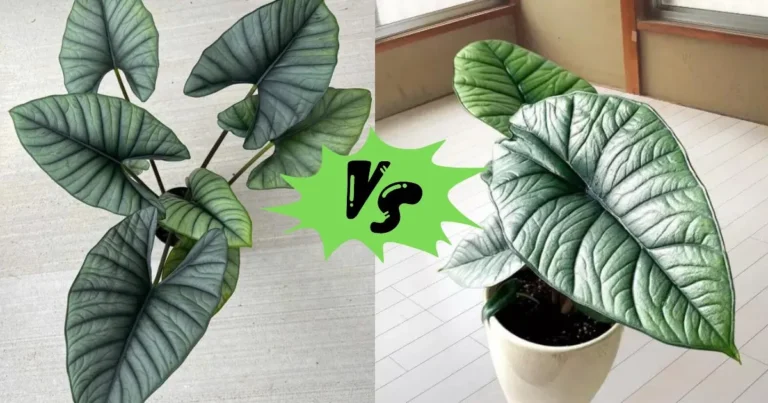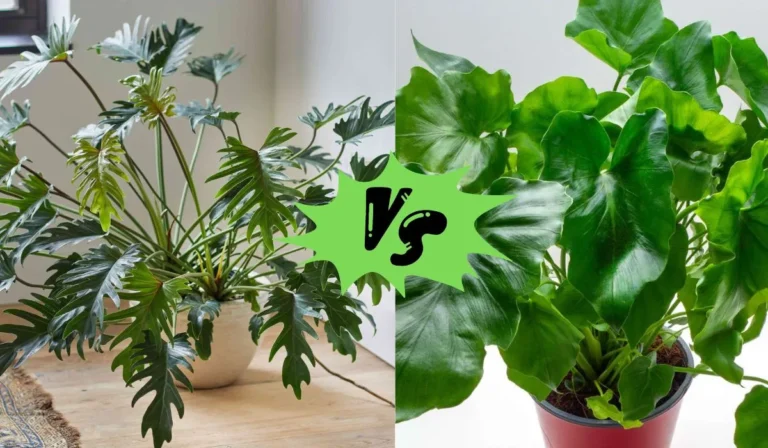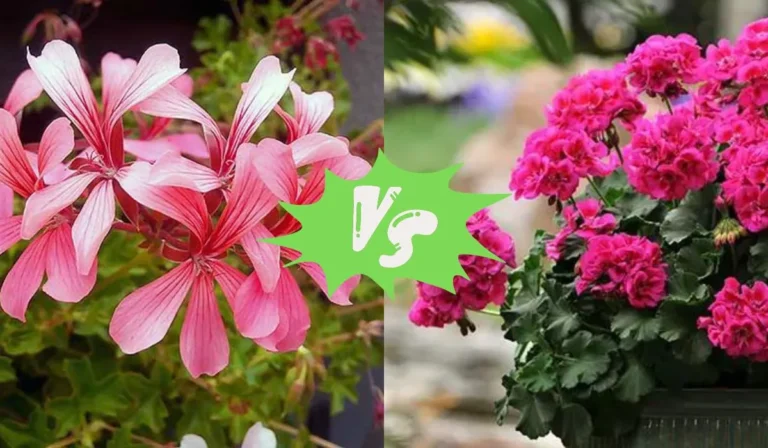Alocasia Odora vs Gageana: Which One is Right for You?
If you’re interested in adding tropical plants to your indoor collection, consider Alocasia. With its large, striking leaves, it can add an exotic touch to any room.
There are different Alocasia varieties, like Alocasia Odora and Alocasia Gageana. In this article, we’ll compare them to help you choose the right one.

Both Alocasia Odora and Alocasia Gageana belong to the Alocasia family but have differences in appearance and care requirements. Alocasia Odora has large, glossy, heart-shaped leaves, while Alocasia Gageana has elongated, pointed leaves with white veins.
For care, Alocasia Odora prefers bright, indirect light, well-draining soil, and regular but not excessive watering to prevent root rot. Alocasia Gageana prefers more shade and a humid environment but also needs regular watering with slightly more moisture-tolerant soil.
Key Takeaways
- Alocasia Odora has large, glossy, heart-shaped leaves, while Alocasia Gageana has elongated, pointed leaves with white veins.
- Alocasia Odora prefers bright, indirect light and well-draining soil, while Alocasia Gageana prefers slightly more shade and a more humid environment.
- When choosing between Alocasia Odora and Gageana, consider your lighting and watering needs, as well as your personal preference for leaf shape and color.
Alocasia Odora Vs Gageana

If you’re looking to add a tropical touch to your indoor or outdoor garden, you might be considering the Alocasia Odora or Gageana.
These two plants are both members of the Araceae family and share many similarities, but they also have some key differences that are worth considering. In this section, we’ll take a closer look at both plants to help you decide which one is right for you.
Understanding Alocasia Odora
Alocasia Odora, also known as Elephant Ear, is a large-leaved plant that is native to Southeast Asia. It is a perennial plant that can grow up to 10 feet tall and 6 feet wide in the right conditions.
The leaves of the Alocasia Odora are glossy green and can grow up to 3 feet long and 2 feet wide. They have a distinct arrowhead shape and are held upright on long, sturdy stems.
Alocasia Odora prefers bright, indirect light and needs to be kept moist but not overly wet. It is a tropical plant that thrives in warm, humid environments, so it’s important to keep it away from drafts and cold temperatures. Alocasia Odora is also toxic to pets and humans if ingested, so it’s important to keep it out of reach.
Understanding Alocasia Gageana
Alocasia Gageana, also known as Giant Taro, is another large-leaved plant that is native to Southeast Asia. It is a perennial plant that can grow up to 10 feet tall and 6 feet wide in the right conditions.
The leaves of the Alocasia Gageana are glossy green and can grow up to 3 feet long and 2 feet wide. They have a distinct arrowhead shape and are held upright on long, sturdy stems.
Alocasia Gageana prefers bright, indirect light and needs to be kept moist but not overly wet. It is a tropical plant that thrives in warm, humid environments, so it’s important to keep it away from drafts and cold temperatures. Alocasia Gageana is also toxic to pets and humans if ingested, so it’s important to keep it out of reach.
Key Differences
While Alocasia Odora and Gageana share many similarities, there are some key differences that are worth noting. Here are a few of the most important differences between the two plants:
- Leaf Shape: While both plants have arrowhead-shaped leaves, the leaves of Alocasia Odora are more elongated and pointed, while the leaves of Alocasia Gageana are more rounded.
- Leaf Color: The leaves of Alocasia Odora are a deep, glossy green, while the leaves of Alocasia Gageana are a lighter green with a slightly yellow tint.
- Size: While both plants can grow up to 10 feet tall and 6 feet wide, Alocasia Gageana tends to be slightly larger and more robust than Alocasia Odora.
- Variegation: Alocasia Odora has a variegated cultivar called ‘Okinawa Silver’, while Alocasia Gageana does not have any variegated cultivars.
Overall, both Alocasia Odora and Gageana are beautiful, tropical plants that can add a touch of exotic flair to any garden.
When choosing between the two, consider the differences in leaf shape, color, size, and variegation to find the one that best suits your needs and preferences.
Cultivating Alocasia Odora

Alocasia Odora is a tropical plant that is native to Southeast Asia. It is a popular ornamental plant due to the impressive size of its leaves, which can reach up to two feet tall at maturity. If you are interested in cultivating Alocasia Odora, here are some tips to help you get started.
Ideal Conditions
Alocasia Odora thrives in warm, humid conditions. Here are some ideal conditions to keep in mind when cultivating this plant:
- Temperature: The optimal temperature range for Alocasia Odora is between 68 to 86 degrees Fahrenheit (20 to 30 degrees Celsius).
- Light: Alocasia Odora prefers bright, indirect light. Direct sunlight can scorch its leaves, so it is best to place it near a window that receives filtered light or provide it with artificial light.
- Water: Alocasia Odora requires consistently moist soil. Water it when the top inch of soil feels dry to the touch. Do not let the soil dry out completely, as this can cause the leaves to wilt and turn yellow.
- Humidity: Alocasia Odora prefers high humidity levels. You can increase humidity by placing the plant on a tray of pebbles filled with water or by using a humidifier.
Common Challenges
While Alocasia Odora is a relatively easy plant to care for, it can still face some challenges. Here are some common issues you may encounter and how to address them:
- Yellowing leaves: If the leaves of your Alocasia Odora are turning yellow, it may be a sign of overwatering or underwatering. Check the soil moisture level and adjust your watering schedule accordingly.
- Drooping leaves: If the leaves of your Alocasia Odora are drooping, it may be a sign of underwatering or low humidity levels. Check the soil moisture level and increase humidity by placing the plant on a tray of pebbles filled with water or by using a humidifier.
- Pest infestations: Alocasia Odora can be susceptible to spider mites, mealybugs, and scale insects. Check your plant regularly for signs of pest infestations, such as webbing, white cottony masses, or small bumps on the leaves. If you detect an infestation, isolate the plant and treat it with an insecticide or insecticidal soap.
By following these tips, you can successfully cultivate Alocasia Odora and enjoy its impressive foliage in your home.
Cultivating Alocasia Gageana
If you’re looking to cultivate Alocasia Gageana, there are a few things you should keep in mind.
This plant requires a bit more attention than some other houseplants, but its striking appearance and unique growth habits make it well worth the effort. Here are some tips to help you cultivate Alocasia Gageana successfully.
Ideal Conditions
Alocasia Gageana thrives in warm, humid environments. Ideally, you should keep your plant in an area that receives bright, indirect sunlight. Direct sunlight can burn the leaves, so it’s important to find a spot that provides plenty of light without exposing the plant to harsh rays.
In terms of temperature, Alocasia Gageana prefers warm, consistent conditions. You should aim to keep your plant in an area that stays between 60 and 80 degrees Fahrenheit. If the temperature drops below 60 degrees, your plant may become dormant, so it’s important to keep it in a warm area throughout the year.
When it comes to watering, Alocasia Gageana requires frequent, consistent moisture. You should aim to keep the soil moist but not waterlogged. You can achieve this by watering your plant thoroughly once a week and misting the leaves with water every few days to increase humidity levels.
Common Challenges
While Alocasia Gageana is a relatively hardy plant, it can be susceptible to a few common issues. Here are some problems you may encounter and how to address them:
- Yellowing leaves: If your plant’s leaves start to turn yellow, it may be a sign that you’re overwatering. Try cutting back on watering and see if the issue resolves itself.
- Brown spots: Brown spots on the leaves can be a sign of fungal or bacterial infections. If you notice this issue, you should remove any affected leaves and treat the plant with a fungicide or bactericide to prevent the spread of the infection.
- Pest infestations: Alocasia Gageana can be susceptible to pests like spider mites and mealybugs. If you notice any signs of infestation, such as webbing or small white bugs, you should treat the plant with an insecticide to eliminate the pests.
By following these tips and keeping a close eye on your plant’s growth and health, you can successfully cultivate Alocasia Gageana and enjoy its unique beauty for years to come.
Choosing Between Alocasia Odora and Gageana
When it comes to choosing between Alocasia Odora and Gageana, there are a few factors to consider. Both plants are stunning and have their unique features, but it’s essential to make the right choice based on your preferences and requirements.
Factors to Consider
Here are some factors to consider when choosing between Alocasia Odora and Gageana:
- Appearance: Alocasia Odora has large, glossy green leaves that are heart-shaped and have a pointed tip. On the other hand, Alocasia Gageana has slightly smaller leaves that are more rounded and have a slightly wavy edge. The leaves of Gageana are also a bit more pointed, and the plant has a more compact growth habit than Odora.
- Growing Conditions: Both Alocasia Odora and Gageana prefer bright, indirect light and consistently moist soil. However, Odora can tolerate slightly drier conditions than Gageana, and it’s also more cold-hardy. Gageana, on the other hand, is more sensitive to cold temperatures and needs to be protected from frost.
- Propagation: Alocasia Gageana is easier to propagate than Odora. Gageana produces more offsets or “babies” than Odora, making it easier to increase your collection or share with friends.
- Availability: Alocasia Odora is less common than Gageana, making it more challenging to find. Gageana, on the other hand, is widely available and can be found at most nurseries or garden centers.
Making the Right Choice
When choosing between Alocasia Odora and Gageana, it’s essential to consider your preferences and requirements. If you prefer a plant with larger, glossy leaves and can tolerate slightly drier conditions, then Odora might be the right choice for you.
However, if you want a more compact plant that’s easier to propagate and can tolerate more humid conditions, then Gageana might be the best option.
Ultimately, both Alocasia Odora and Gageana are stunning plants that can add a touch of tropical beauty to any indoor or outdoor space. By considering the factors mentioned above, you can make the right choice and enjoy the beauty of these plants for years to come.
Frequently Asked Questions
What are some differences between Alocasia gageana and Alocasia macrorrhiza?
Alocasia gageana and Alocasia macrorrhiza are often confused with one another. However, there are some differences between the two plants that can help you distinguish them.
One of the most significant differences is that Alocasia gageana has more rounded leaves than Alocasia macrorrhiza. Additionally, Alocasia gageana typically grows smaller than Alocasia macrorrhiza, reaching heights of only 2-3 feet.
Is Alocasia gageana a rare plant?
No, Alocasia gageana is not considered a rare plant. In fact, it is widely available in many nurseries and garden centers. However, it is important to note that the variegated form of Alocasia gageana is less common and may be more difficult to find.
How tall can Alocasia gageana grow?
Alocasia gageana can grow up to 3 feet tall, making it a great choice for those looking for a smaller plant to add to their collection. However, it is important to note that the plant’s height can vary depending on the growing conditions and care it receives.
What are some characteristics of Alocasia odora variegata?
Alocasia odora variegata is a stunning plant with large, glossy leaves that are variegated with shades of green and white.
This plant can grow up to 6 feet tall and is a great choice for those looking for a statement plant. However, it is important to note that Alocasia odora variegata can be more difficult to care for than other Alocasia varieties.
How do you care for Alocasia Lukiwan?
Alocasia Lukiwan is a relatively new variety of Alocasia and is known for its unique leaf shape.
To care for this plant, it is important to keep it in a well-draining soil mix and to water it regularly. Additionally, Alocasia Lukiwan prefers bright, indirect light and high humidity levels.
What distinguishes Alocasia infernalis from other Alocasia varieties?
Alocasia infernalis is a unique variety of Alocasia that is known for its dark, almost black leaves. This plant prefers bright, indirect light and high humidity levels.
Additionally, it is important to note that Alocasia infernalis can be more difficult to care for than other Alocasia varieties and may require more attention to thrive.






